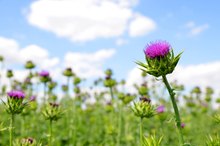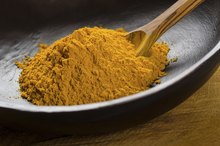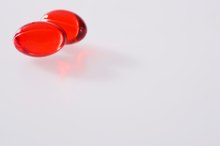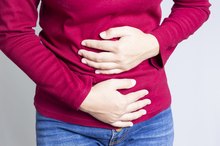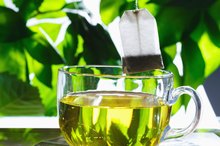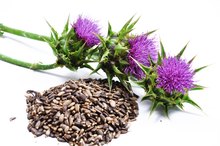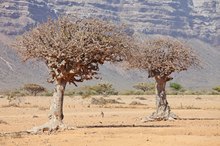Herbs for Liver Cysts
Liver cysts are fluid-filled sacs that do not require treatment unless symptoms develop, such as abdominal bloating or pain. Even though liver cysts are benign and do not cause liver failure, they can signal the presence of an underlying disorder, such as polycystic liver disease or a parasitic infection. In addition to surgical removal, traditional herbal medicines may help to prevent reoccurrence. Discuss all of your treatment options with your doctor before attempting self-treatment with complementary therapies.
If you are experiencing serious medical symptoms, seek emergency treatment immediately.
Milk Thistle
This herb contains active compounds called silymarin and silybin that the “Physicians’ Desk Reference for Herbal Medicines” describes as hepatoprotective, meaning they protect the liver by blocking toxin-binding receptor sites in the cells of the organ’s outer membrane 2. A review published in the "World Journal of Gastroenterology" in May 2011 finds that both silymarin and silybin demonstrate antioxidant, anti-inflammatory and anti-fibrotic properties 3. Also, a study published in the July 2011 issue of "Cardiovascular Diabetology” reports that silibinin depletes a protein metabolite that damages the lining of blood cells, or endothelium in diabetic rats 4. Consult your physician before taking milk thistle if you take other medicines because this herb may interfere with their metabolism in the liver.
Dandelion
Fatty Liver & Chamomile Tea
Learn More
According to a study published in the "Journal of Ethnopharmacology” in August 2010, dandelion demonstrates anti-fibrotic properties and promotes the regeneration of liver cells in mice. In the May 2010 issue of "Food and Chemical Toxicology,” scientists discuss the effects of two polysaccharides from dandelion that significantly decrease the activity of certain enzymes responsible for producing inflammation and liver lesions. Do not take dandelion preparations without talking to your doctor if you have diabetes, use antacids, or take antibiotics or medications for bipolar disorder because of possible herb-drug interactions.
- According to a study published in the "Journal of Ethnopharmacology” in August 2010, dandelion demonstrates anti-fibrotic properties and promotes the regeneration of liver cells in mice.
- In the May 2010 issue of "Food and Chemical Toxicology,” scientists discuss the effects of two polysaccharides from dandelion that significantly decrease the activity of certain enzymes responsible for producing inflammation and liver lesions.
Artichoke
Artichoke leaves and roots contain compounds that stimulate bile flow and reduce fat concentration. A study published in "Phytotherapy Research" in May 2010 states that artichoke extract positively affects cellular respiration in the livers of rats 89. Another study published in the same journal in 2008 shows that artichoke protects endothelium cells by suppressing the formation of reactive toxins that occur as byproducts of normal metabolism. Do not take artichoke extract without medical supervision if you have a history of gallstones or a bile duct blockage.
- Artichoke leaves and roots contain compounds that stimulate bile flow and reduce fat concentration.
- Another study published in the same journal in 2008 shows that artichoke protects endothelium cells by suppressing the formation of reactive toxins that occur as byproducts of normal metabolism.
Green Tea
Milk Thistle and Liver Enzymes
Learn More
In the July 2007 issue of "American Journal of Physiology, Cell Physiology,” scientists propose that the key to reducing liver cysts is to prevent the abnormal growth of epithelial cells by suppressing vascular endothelial growth factor. Agents that suppress VEGF are called angiogenesis inhibitors and, according to a study published in the April 2006 issue of the “International Journal of Cancer,” green tea is one of them. The scientists further note that green tea compounds block other factors that allow the growth of rogue blood vessels from existing capillaries, such as interleukin-8. Consult your physician before using green tea if you take other medications to avoid interactions.
- In the July 2007 issue of "American Journal of Physiology, Cell Physiology,” scientists propose that the key to reducing liver cysts is to prevent the abnormal growth of epithelial cells by suppressing vascular endothelial growth factor.
Related Articles
References
- Cleveland Clinic: Liver Cysts and Tumors
- Physicians’ Desk Reference for Herbal Medicines: Thomas Brendler, et al.
- World Journal of Gastroenterology: Silybin and the Liver: From Basic Research to Clinical Practice
- Cardiovascular Diabetology: Effect of Silibinin on Endothelial Dysfunction and ADMA Levels in Obese Diabetic Mice
- Journal of Ethnopharmacology: Antifibrotic Activity of Taraxacum Officinale Root in Carbon Tetrachloride-Induced Liver Damage in Mice
- Food and Chemical Toxicology: TOP1 and 2, Polysaccharides from Taraxacum Officinale, Attenuate CCl(4)-induced Hepatic Damage Through the Modulation of NF-kappaB and Its Regulatory Mediators
- University of Maryland Medical Center: Dandelion
- Phytotherapy Research; The Effect of Artichoke (Cynara scolymus L.) Extract on Respiratory Chain System Activity in Rat Liver Mitochondria
- Phytotherapy Research: The Effect of Artichoke (Cynara scolymus L.) Extract on ROS Generation in HUVEC Cells
Resources
- American Journal of Physiology, Cell Physiology: VEGF Receptor Inhibition Blocks Liver Cyst Growth in pkd2(WS25/-) Mice
- International Journal of Cancer: Green Tea Catechin, Epigallocatechin-3-gallate, Inhibits Vascular Endothelial Growth Factor Angiogenic Signaling by Disrupting the Formation of a Receptor Complex06
Writer Bio
Karyn Maier is a seasoned columnist and feature writer. Since 1992, her work has appeared in Mother Earth News, The Herb Quarterly, Better Nutrition and in many other print and digital publications. She is also the author of five books, and is published in six languages.

